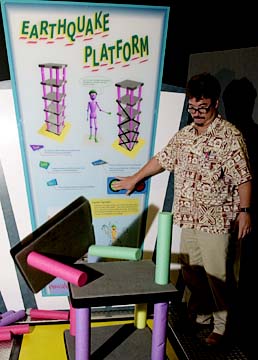Advertisement - Click to support our sponsors.


Museum theory:
engineering
can be cool
By Burl Burlingame There is pure science, and there is applied science, and "Engineer It!," the new exhibit at Bishop Museum, takes you from one discipline to another.
Star-Bulletin"Rita Caldwell, director of the National Science Foundation, is pretty insightful about that," said museum director W. Donald Duckworth. "She says one of the primary problems with colleges and universities are that they are organized by disciplines -- while society's troubles are interdisciplinary by nature."
This means you might have a theoretical physicist with no clue how a hot-water heater works, or a plumbing engineer with no idea how water is heated by either conduction, convection or radiation.

"Engineer It!" was created by the Oregon Museum of Science and Industry to introduce "kids of all ages" to the basics of engineering. It uses a variety of hands-on exhibits to illustrate the problems of wind, gravity, water and earthquakes on constructed objects.Why engineering in a culture and science museum?
"Simple," Duckworth said. "Engineering is the application of the knowledge of science to solve problems. It's practical, not theoretical. The higher you go in the education process, the greater the disjuncture between acquiring knowledge and applying it. The trick is to use 'science' as a verb, rather than a noun."
Wayne Castro, of the museum's buildings and grounds department, graduated from the University of Hawai'i as a civil engineer, and has trouble keeping his hands off the hands-on exhibits.
On exhibit
What: "Engineer It!" grand opening
Place: Bishop Museum Castle Building, 1525 Bernice St.
Date: 9 a.m. to 5 p.m. Sunday
Admission: $3 for residents and military; $14.95 for non-residents; free to Hawaiian Miles card holders and ages 4 and younger
Call: 847-3511
Note: The exhibition will continue through January during museum hours; regular admission.
"As people come in, they go right to the giant crane," he said, referring to something that looks like a colorful Erector set on steroids. "They spin the wheels, they try to pick up objects from the conveyor belt, they go over to the water area and splash around, they're making paper airplanes and testing them in the wind tunnel, they're building bridges out of blocks to see if they'll fall down ... you see a lot of grandparents 'taking the kids' who are playing with the exhibits!"
As much as patrons play, the exhibits offer fundamental lessons in real-world problems, said Castro. "How do you build a tall building that will hold up in an earthquake? How do you make an airplane's wings stable? Engineering touches every part of our lives."
Scientists, suggests Castro, are the "idea guys," and engineers are the "go-do-it guys. The ironic thing is that scientists often need a staff engineer to design their experiments."
Technician Mark Keppinger of the Oregon museum said OMSI was able to draw upon the northwest's large population of technicians and engineers to help with the exhibit. Intel, for example, aided with the electronics, and Boeing helped with the aviation aspects.
"We worked hard on making an interactive exhibit that was rugged as well," he said. "All the electronics are industrial-strength and off-the-shelf, the controls are same as arcade games, most things can be fixed with contact cement."
"The real challenge of making an interactive display is making exhibitry that stands up under interactivity," said Duckworth.
Call it This-Old-House Syndrome. The "Engineer It!" exhibit is likely to appeal to anyone who looks through the fence at a construction site.
"People love to watch stuff being built. If Hawaii is going to become a player in high-tech fields, we need to excite kids by this kind of learning," said Duckworth.
What did this highly educated museum professional learn from the exhibit?
"Catenary arches!," he said, pointing to a graceful, looping shape very much like the St. Louis Gateway arch, made of padded blocks with numbers on them.
"A catenary is the shape a rope or chain makes as it hangs between two points, and if you turn the shape upside down, it makes a structurally sound arch, with all the pressure passed downwards, through the blocks, instead of outwards. Get the blocks in the wrong order, it alters the shape, and the arch becomes unstable. Pretty cool."
Click for online
calendars and events.